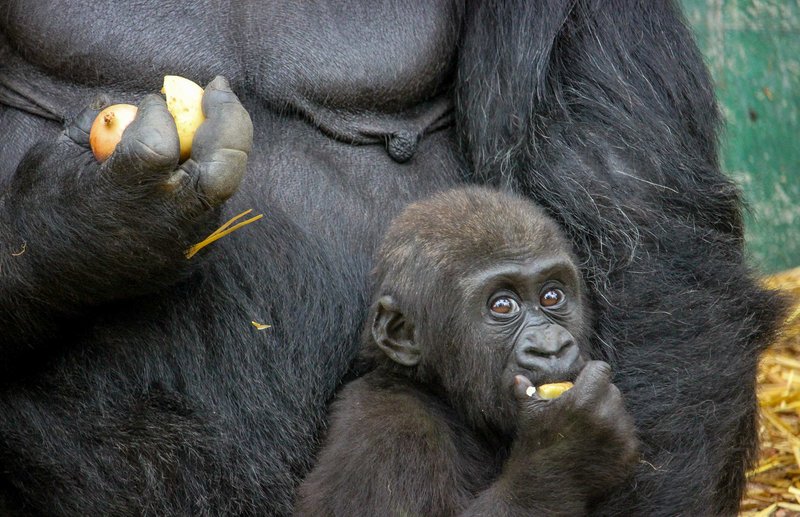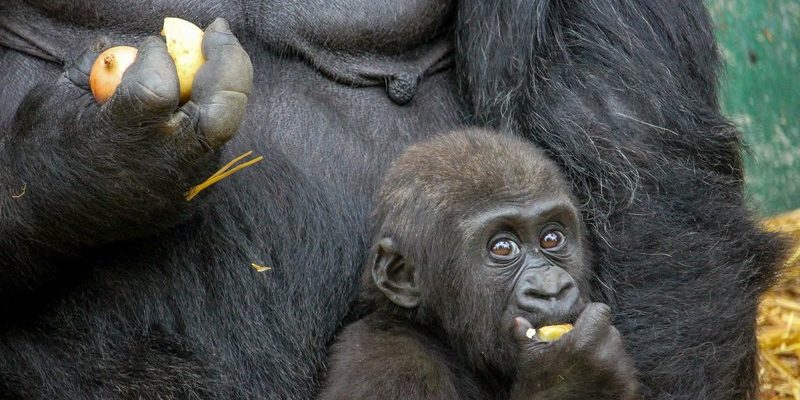
Imagine a close-knit family unit where love, protection, and teaching are constant themes. Western gorillas, found predominantly in the dense rainforests of Central Africa, exhibit these qualities beautifully. Here’s a closer look at how they manage the complex yet essential task of raising their young in the wild.
The Role of Mothers in Gorilla Families
Western gorilla mothers are the primary caregivers for their young. They spend nearly every moment with their infants, particularly in the first few years of life. This hands-on approach allows the little ones to learn vital survival skills and social behaviors. The bond between a mother and her baby is incredibly strong, characterized by physical touch and vocal communication.
Mothers will often carry their babies on their bellies or backs, to keep them safe as they navigate their forest home. This constant contact helps the infants feel secure, much like how human parents carry their newborns close. Over time, you’ll see this dynamic evolve as the young gorillas gain confidence and start to explore their surroundings while still returning to their mothers for comfort and support.
Interestingly, a mother’s role doesn’t end at just feeding and protecting her young. She also teaches them how to forage for food and engage in play with other gorillas. This playtime is crucial, as it not only helps build social skills but also strengthens family bonds within the troop.
The Importance of Social Structures
Western gorillas live in groups known as troops, which typically consist of several females, their offspring, and a dominant male known as a silverback. This structure plays a vital role in the upbringing of young gorillas. The silverback is responsible for the safety of the troop, and his presence provides a sense of security for the entire family.
Within this social setup, you might find young gorillas learning from not just their mothers but from other members of the troop as well. Older siblings often take on the role of caregivers, mimicking their mothers by grooming and playing with the younger ones. This shared responsibility helps foster a sense of community, enabling infants to thrive in a supportive environment.
Moreover, interactions with peers are just as important. Young gorillas engage in play-fighting, climbing, and swinging through the trees, which teaches them essential life skills. By watching and participating, they learn about the social hierarchies of their troop and how to navigate relationships, much like how human children learn from their peers.
Feeding is a significant part of a young gorilla’s life. From the moment they are born, gorilla infants rely on their mother’s milk, which provides all the nutrients they need in those early months. After about six months, though, they start to nibble on solid foods. They’ll often mimic their mothers by trying leaves, fruits, and flowers, which are a staple of a gorilla’s diet.
This gradual introduction to solid food is crucial. It’s not just about sustenance; it’s also an opportunity for mothers to teach their babies about what’s safe to eat. Mothers will often lead their young to specific plants that are rich in nutrients, showing them how to select the best leaves or fruits. This learning experience is essential for their survival as they grow older and start to forage independently.
The skill of foraging is more than just eating. It’s about recognizing the ecosystem, understanding seasonal changes, and knowing where to find food. In this regard, Western gorillas don’t just survive; they thrive through maternal guidance and experiential learning.
The First Steps of Independence
As gorilla infants grow, they start to explore their world more independently. This phase can be both exciting and daunting for them. You might see them venturing away from their mothers for short periods, testing their limits while still staying close by. It’s a bit like how human kids take their first steps away from a parent—filled with a mix of curiosity and a desire for safety.
Around the age of two to three years, young gorillas start to engage in more complex social interactions. They play with their peers, develop friendships, and even form alliances. This social development is crucial for their future roles in the troop. It sets the groundwork for how they will interact with other gorillas and contribute to the community.
During this time, mothers remain supportive but gradually encourage their young to become more self-reliant. They’ll step back a bit, allowing their infants to make mistakes and learn from them, which is just as crucial as any lesson taught.
The Risks and Challenges of Raising Young
Raising young gorillas in the wild is not without its challenges. Predators, human encroachment, and diseases can pose serious threats to a mother and her offspring. Protective instincts kick in full force when there is danger. Mothers will use vocalizations to warn their young and will move them quickly to safe areas.
These challenges also impact the number of offspring that survive to adulthood. Gorillas typically have low birth rates, with females giving birth approximately every four years. This slow reproduction rate means that each infant is precious, and every successful upbringing is critical for the troop’s future.
Environmental changes, like deforestation and poaching, further complicate their survival. Conservation efforts play a vital role in safeguarding these magnificent creatures and ensuring they can continue to raise their young in their natural habitat.
In many ways, the way Western gorillas raise their young reflects the deep-rooted instincts of protection, love, and learning. From the strong bond between mothers and infants to the supportive community of the troop, every aspect of their upbringing is carefully crafted for survival and growth. Watching this interaction in the wild reminds us of the profound connections we share with all living beings.
As we learn about gorillas and their family structures, it becomes clear that their parenting styles are not just instinctual—they’re also a testament to their intelligence and emotional depth. Protecting their habitats and supporting conservation efforts is essential so that future generations of Western gorillas can thrive and continue this incredible journey of nurturing in the wild.

